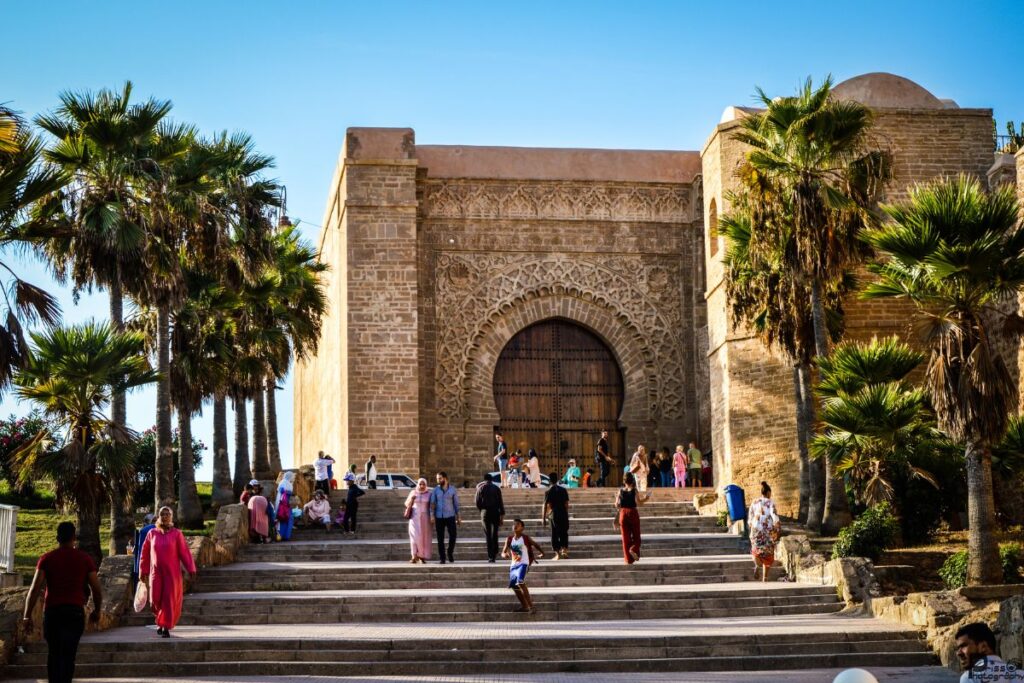
Rabat Morocco travel
What to do and see in Rabat, Rabat is the political capital, the primary administrative center of Morocco, and the fourth imperial city. The city presents a unique blend of historical traditions from the past and modernity established in the present. It was founded in the 12th century by Abd al-Mumin, who utilized his kasbah (fortress) as a base to fight against the Spaniards.
Rabat’s most iconic buildings were constructed during this time, such as the Hassan Tower and the Kasbah of the Udayas. In the early 17th century, the city became a haven for Muslims expelled from Spain. Today, Rabat remains a hub of culture, politics, and commerce, drawing visitors worldwide to experience its unique blend of history and modernity.
Rabat, Morocco
Rabat, the capital city of Morocco, is situated on the Atlantic coast at the mouth of the Bu Regreg River. The river divides the city into two parts, Rabat and Salé. Rabat is known for its open and dynamic character, while Salé is often seen as more reserved.
How to get to Rabat
The Mohammed V International Airport is situated a short distance east of Rabat and is well-connected to the city by bus. Travelers can also find flights to Rabat from Paris with Royal Air Maroc, Air France, and Jet4you. However, checking the airport, nearby Casablanca, is recommended for more international flights. Bargain hunters should keep an eye out for cheap flight deals to Morocco.
Morocco train
Rabat is well connected to other cities in Morocco through its modern train station in the city center, which offers daily departures to cities like Meknes, Fes, Tangier, Casablanca, Marrakech, and Oujda. The bus station (Gare Routiere) is also available with departures to the main cities in Morocco, although it is located around 5 kilometers from the city center.
A little history about Rabat
Archaeological evidence suggests that the Carthaginians and Phoenicians inhabited Rabat before the arrival of the Romans. The name Rabat is derived from the word Ribat, meaning “Islamic fortress,” as the first structure built in the area was intended to defend against Berber tribes. It was not until the reign of Yacoub Al-Mansur in 1184 that the city experienced significant growth, with the construction of civil and religious buildings and the establishment of Rabat as the capital of his empire.
Rabat, The Capital of Morocco
In 1912, Marshal Lyautey designated Rabat as the administrative capital of the French Protectorate of Morocco. After Morocco gained independence in 1956, Rabat became the country’s capital. Due to its unique history, Rabat has a blend of traditional and modern influences from both Islam and Europe, making it a city with a unique cultural and architectural identity.
Is Rabat a touristy?
In Rabat, tourism is not so widespread and few inhabitants are involved. That allows you to walk quietly through the markets without protecting yourself against excessive pressure from sellers.
What to see in Rabat
Being the country’s capital, Rabat is not precisely one of the main tourist destinations of Morocco, although it must be said that this city deserves special mention. The city has been known as ‘The City of Gardens’. As we have said, Rabat is a perfect combination of old and modern cities. It is one of the most dynamic and commercial cities in the country.
Rabat Monuments
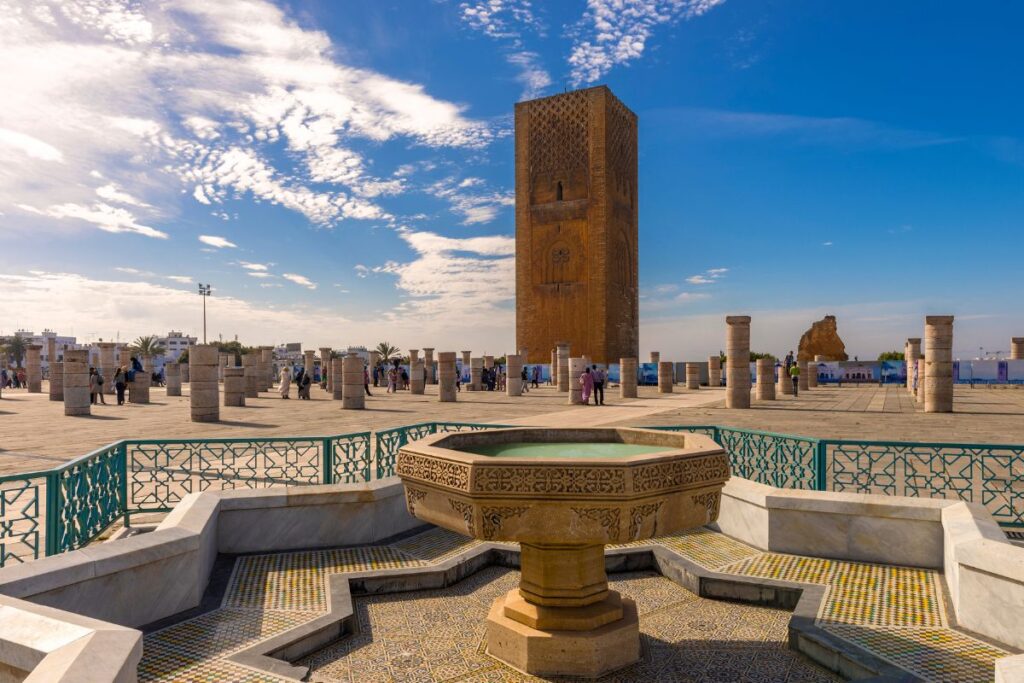
The Hassan Tower is a must-see monument in Rabat, known for being one of the three large minarets built by the Almohads. Although the tower was initially intended to be part of the largest mosque in the world, construction stopped after the death of Sultan Yacoub Al-Mansur. The tower stands at 44 meters, only half of the originally planned 86 meters.
The Lisbon earthquake caused damage to most of the columns and walls of the monument. The tower is architecturally similar to the Koutoubia of Marrakech and the Giralda of Seville, as they were all designed by the same architect.
The mausoleum of Mohammed V in Rabat
The Mausoleum of Mohammed V is one of Morocco’s most important modern art constructions, located next to the Hassan Tower. It is the resting place for the Alaouist monarchs Mohamed V and Hassan II, the grandfather and father of the current king, Mohamed VI. The mausoleum is made of marble with a refined decoration and consists of a mosque and a Kubba, a tomb covered by a dome built in Italian white marble. Visitors can tour the mausoleum daily from 8:00 a.m. to 6:30 p.m.
The Great Mosque of Rabat
The Great Mosque of Rabat, built in the fourteenth century, is composed of a minaret of a square plan and decorated by arches in the shape of a horseshoe. A little beyond the mosque is the jewelry souk, where formerly representatives of foreign powers resided.
Rabat old city (Medina)
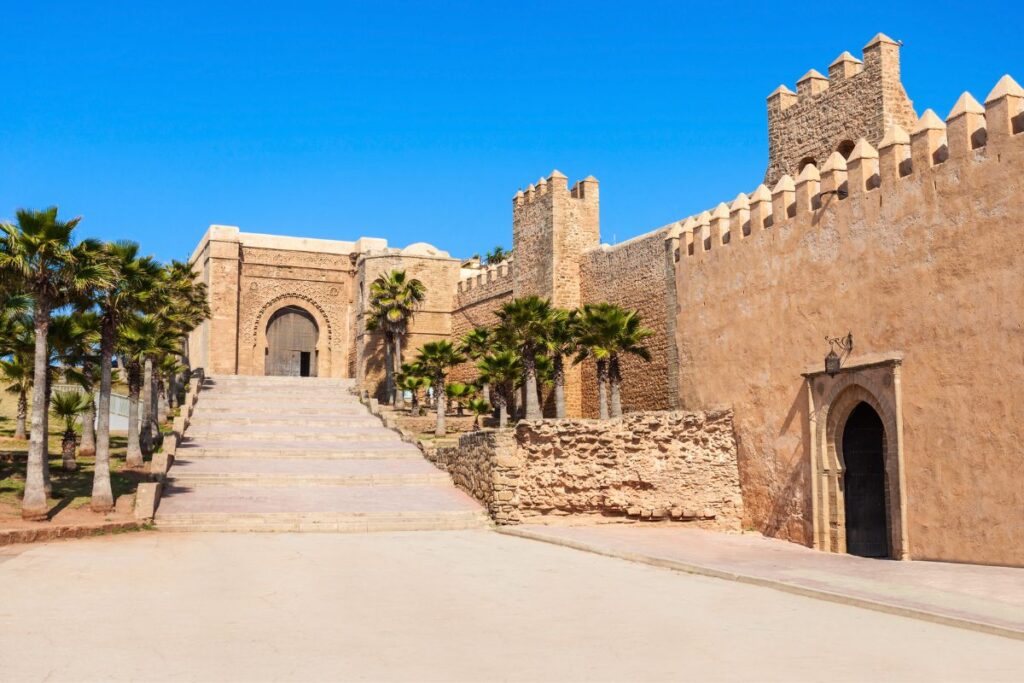
The medina is surrounded by two walls of different times. In the south, the Walls of the Andalusians, of reddish tones bordered by the Boulevard Hassan II, which separates it from the modern city. The Jewish quarter (Mellah) is accessed through the Bab Mellah gate in the eastern part of the walls. In the western part, we find the walls of the Almohades, finished building in 1197. You can see 5 of its doors today, but the most interesting to visit is Bab er-Ruah. The walls of Rabat are more than 5 km long and surround the medina on three sides.
The Kasbah des Oudaias
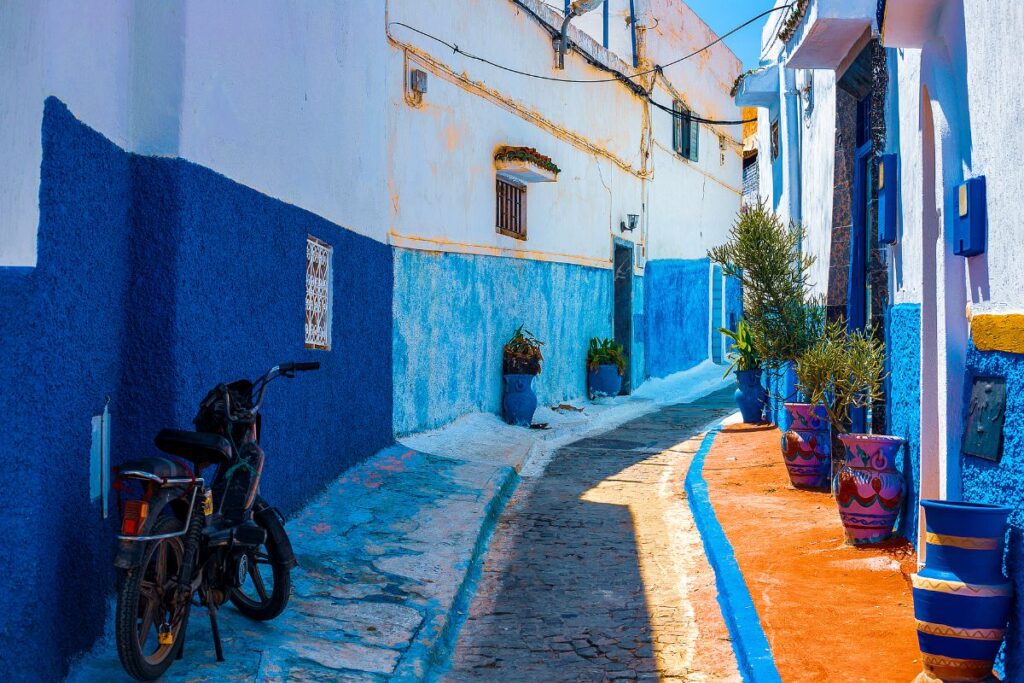
The Kasbah des Oudaias (or the medieval Kasbah of the Udayas) is a place that we recommend as a must since it is one of the city’s most beautiful areas. Walls form that shelter a walled neighborhood made up of narrow and well-kept alleys full of houses painted in blue.
A sandstone door from the Almohad era accesses it. In addition, inside the kasbah is the garden of the Andalusians, created at the beginning of the 20th century in the Arabic-Andalusian style, and the Museum of Decorative Arts of Rabat. It is interesting to visit the building and its collection of jewelry and textiles.
The Kasbah was built on a cliff over the Atlantic, housing an old palace converted into a traditional art museum. Beyond the walls are the remains of the ancient Salé, whose Archaeological Museum is one of the most interesting in Morocco.
It is here where the important battle took place where the tribe of the Oudayas, commanded by Moulay Ismaïl, defended the city from the Andalusian pirates. This Kasbah is picturesque, with houses and streets outside Rabat’s standard. It is a perfect place to walk and relax or have a good Moorish tea in the pleasant Moro café with views of the sea and the neighboring town of Salé.
Rabat Medina
The kasbah has magnificent views of the sea, accompanied by the soothing sound of the waves hitting the walls. Near the kasbah, the old walled medina houses the souk, which is in the full bustle at dusk, especially in the streets of Souïqa and the Cónsules, full of shops of all kinds.
Chellah Rabat Morocco
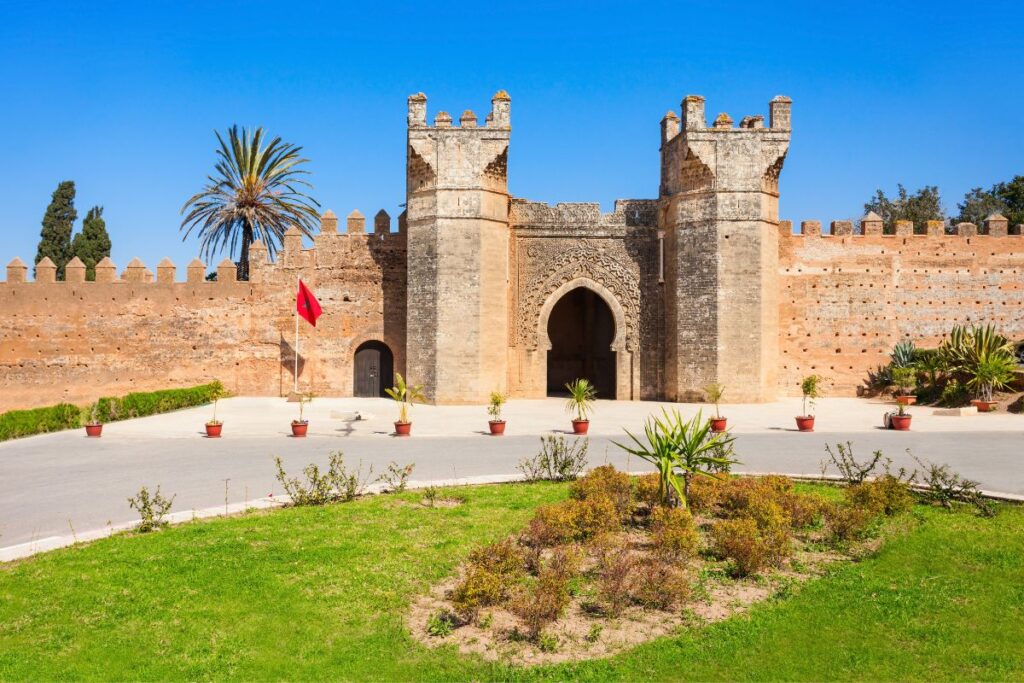
A little further from the center, it is worth visiting the necropolis of Chellah, an impressive maritime fortress. Gigantic castle built on the ruins of the ancient city of Sala. The Black Sultan, Abu al Hassan, was the one who built the complex in which he remains now resting. Within the necropolis are Roman vestiges and Arab monuments.
Here you can see ruins of a Roman forum, remains of houses and shops, a mausoleum, a hammam (bath), a madrasa (school), a mosque, and an exotic garden. In addition, the place is a refuge for storks so you can see dozens of them.
Rabat attractions
The new part of Rabat (Ville Nouvelle) was the first that the French built during their Protectorate in 1912, with the idea of building a new neighborhood on the outskirts of the medina to house the French bureaucrats. Although in Rabat, tourism is concentrated in the places indicated above, here are the main institutions in an axis formed by the elegant Avenue Mohammed V, full of palm trees and fountains: the seat of Parliament, the Bank of Morocco, the Post office, the railway station and the historic hotel Balima. All of them make up a set of buildings in Arabic-Art Deco style.
Mechouar Rabat
After the Parliament and the Great Mosque, we find a walled district called Mechouar, where members of the Government and the Royal House live. Within this neighborhood is also the Royal Palace.
In summary, this is a list of what you have to see in Rabat:
Kasbah of the Oudaias
Hassan Tower and the Royal Mausoleum
Old Medina
Chellah: ancient city founded by the Carthaginians. You can walk from the city center, but it is long. Admission costs approximately 10 DH and is open until 5:30 PM.
National Archaeological Museum
Bank Al Maghrib Museum
The beach
Royal Palace: it is very big, and it is worth contemplating in a walk around its surroundings
What to do and see in Rabat
In the kasbah (Oudaia), there is a cafe with incredible views over the sea, where you can drink Moorish tea and pasta. The personnel is very friendly. There is also a large and quiet park next to one of the best hotels in Rabat, the Sofitel, where people run and play football, etc. In addition, you can use the pool at the Sofitel hotel to take a bath. The park is a 10-15 Dirham taxi (10 minutes) from the Central Station.
This is a list of things to do in Rabat if you like culture and leisure:
Theater Mohamed V. Nothing exceptional, but with performances every month.
Jazz au Chellah. It is a jazz festival organized every June by the Ministry of Culture, the city council of Rabat, and the European delegation. The website sometimes fails.
Mawazine It is a world music festival annually in Rabat, with great icons of Arabic, African, and international music. It takes place in May. It is controversial because some of the country’s Muslim politicians have criticized the festival “for encouraging immoral behavior.” Artists like Stevie Wonder, Carlos Santana, Elton John or BB King have performed at Mawazine.
Amnesia 18. Rue de Monastir, Rabat center. The latest in fashion to dress up.
Royal Golf Dar Es Salam. It extends over 440 hectares of trees, flowers, and water. If you have enough money and means of transport and are looking for a quiet place to walk or play golf, you will like it.
Security
Rabat is considered a safe city. You must use common sense: avoid using expensive visible jewels and walking through unseasonably touristy and deserted areas at night.
If you walk through the crowded streets of the medina or use the bus, be careful with your pockets. Women must do without necklines, skirts or pants too short to avoid harassment (which usually goes beyond a comment or look, but nothing physical). But this problem occurs to a lesser extent here than in other cities since Rabat is a modern city accustomed to the West.
Surroundings
Salé is on the right bank of the Bou Regreg river, in front of Rabat. Founded as a Phoenician colony in antiquity, it became a haven for pirates as an independent republic before joining Morocco. The modern Salé is more polluted than Rabat and worse planned due to its rapid expansion due to the rural exodus. The city has become a great ‘dormitory city’. Most of its rich and influential inhabitants moved to Rabat, on the other side of the river. A bridge, a tram line, and a boat (2 DHS) connect the two cities.
Skhirat is a small town 28 kilometers from Rabat, known for its beaches. The area around Skhirat has started to develop recently, and the prices of properties and land have skyrocketed.
Where to eat in Rabat
Top restaurants in Rabat
In Rabat, it is easy to find stalls selling food at a good price and generally of good quality. Most of the food is made with pasta and meat, and do not forget to try the traditional kebab with spicy sauce and harira, a very nutritious typical soup. It is not usual to find alcoholic beverages, but many pubs are open until dawn and many cafes and bars have a beer.
Most of Rabat’s restaurant hotels are between the historical central park (Jardins Triangle de Vue) and the main train station. Many of the bars and cafes in this area have all kinds of beers, kebabs, pizza, olives, and ice cream to kill hunger and enjoy a break in the trip. The Atlantic coast is very close to Tamesna, and, precisely, there is a luxurious hotel with charm.
L’Amphitrite Palace Hotel in Skhirat is the best place to stay and eat by the ocean. The dining room is almost on the beach and the menu is of the French type, an elegant and original mix. Among the main dishes are the foie gras, the salmon, the duck magret, and the desserts, delicious to taste and beautiful to look at. In addition, the wine list is special, with abundant French wines and high quality. The Atlantic sun and the sea breeze will be the appetizer of the banquet.
A tip of 5-10% of the bill is usually provided if you are satisfied with the service.
La Comédie de Mohamed V. Pastry Shop Do you want cakes? Croissants, 4 dh. Ice cream, 6 DH per tablespoon.
Cafe 7eme Art is located next to the movie theater. They serve light lunches, popular with business people and the better-off. Pizzas, from 35 to 40 dh.
Le Majestic Le Majestic
Ty Potes Ty Potes
Cafe de Weimar
Pizza Hut. 05 37 68 13 00 for the Agdal district, 05 37 63 02 00 for the Souissi district.
Villa Mandarine is considered one of the best restaurants in Rabat
Le Petit Beur / Dar Tagine Delicious bunt. Intimate atmosphere.
The Rancho Tex-Mex restaurant. Good food is one of the few places to enjoy a good beer.
Mega Mall. Free WiFi Hotspot
Gourmet Pizza
Paul’s Traditional French bakery, which serves as a restaurant. It can be quite expensive, but the food is superb. It is worth visiting for its olive bread.
The Mamma. One of the oldest pizzerias in the city.
Ya Mal Al-Sham (Sirius restaurant)
Matsuri Matsuri
Dar Naji
Le Grand Comptoir
Old Medina. In the center, low-cost food stalls often serve delicious fish, sandwiches, and salads. Especially in the perimeter of the Central Marches, these places also serve hot bean dishes (beans) or lentils, roasted chicken, and homemade tagines. There are also lots of stalls selling pancakes and chocolate bread.
What to do and see in Rabat at night
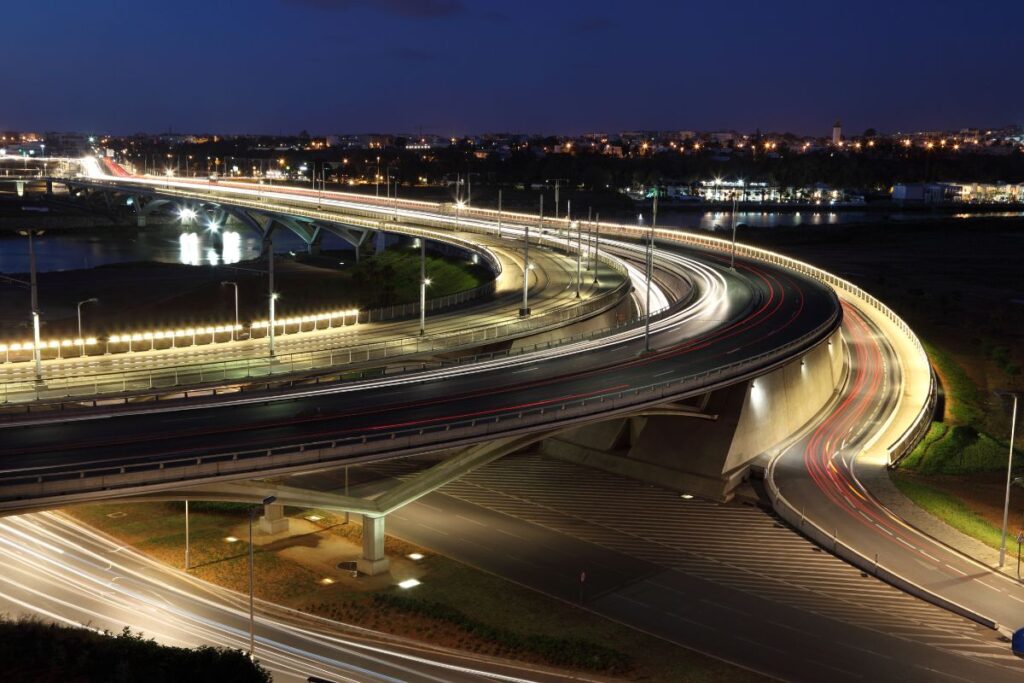
Hotel Balima. Ave. Mohd V.
Upstairs. 8 Avenue Michlifen. Women feel comfortable here, as it is not just for men like the typical Moroccan locals. The food is typical of pub grub, with some vegetarian options. A pint costs 50 dirhams. There is live music from time to time (see his Facebook page)
Café Weimar
Le Bistrot Pietri. It is a very modern elegant restaurant and a bar. On the night of Tuesday and Friday, there is a live jazz concert, and rock ‘n roll on Saturdays. A beer costs around 38 DHS and a glass of house wine costs around 50 Dhs. It is usually filled on weekends. To get a table, it is advisable to book
The Ranch, Agdal.
The Palatino.
Ty Potes.
The covers.
Le Deux Palais (between Sofitel and the Ministry of the Interior). Good food and is the perfect place to see a football match in Rabat, both inside and on the playground. The food is pretty good, too, 10 dh for a plate of french fries.
Chantilly Bar: Located on Avenida Patricio Lumumba, drinks are cheap.
15 dirhams for local beer bottles and 15 dirhams for special beer. It is open until 10:30 p.m. every day.
Where can I go for a peaceful walk in Rabat?
Head to the Andalusian Garden or the Chellah Necropolis for a peaceful walk.
What is the best time to visit Rabat?
The best time to visit Rabat is spring (March to May) and autumn (September to November).
Can I visit the Royal Palace in Rabat?
The Royal Palace in Rabat is not open to the public, but you can admire the impressive gates and walls from the outside.
What is the best way to get around Rabat?
The best way to get around Rabat is on foot, as most attractions are in the medina or within walking distance.
Is it safe to visit Rabat as a tourist?
Yes, Rabat is generally a safe city for tourists. However, it is always important to take basic safety precautions.
Are there any cultural events or festivals in Rabat?
Rabat hosts several cultural events throughout the year, including the Mawazine Festival, the Festival International de la Ville de Rabat, and the Printemps des Alizés.
What souvenirs should I buy in Rabat?
You can find many unique souvenirs in Rabat, such as traditional Moroccan carpets, ceramics, and leather goods.
Where can I go for a panoramic view of Rabat?
The top of the Hassan Tower offers a stunning panoramic view of Rabat, as does the rooftop terrace of the Cafe Maure in the Kasbah des Oudaias.
What can I do in Rabat at night?
You can enjoy traditional Moroccan music and dance performances, dine at local restaurants, or take a romantic walk by the beach.
What are the best outdoor activities to do in Rabat?
The best outdoor activities in Rabat are visiting the Oudaias Gardens, strolling along the beach promenade, and exploring the Bouregreg River.

